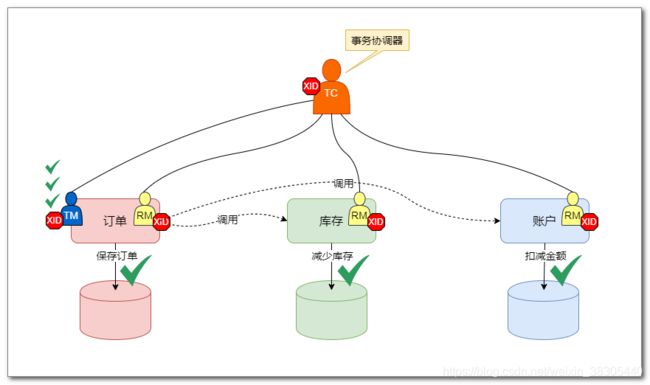微服务之分布式事务Seata
Seata AT模式(全自动事务,只需配置即可)
服务端搭建
分布式事务/seata-server-1.3.zip
Seata Server 配置
Seata Server - TC全局事务协调器
介绍了 AT 事务的三个角色:TC(事务协调器)、TM(事务管理器)和RM(资源管理器),其中 TM 和 RM 是嵌入在业务应用中的,而 TC 则是一个独立服务。
配置 registry.conf配置文件--注册
选择eureka并设置合适的路径及服务名称
Seata 支持多款注册中心服务:nacos 、eureka、redis、zk、consul、etcd3、sofa。
我们项目中要使用 eureka 注册中心,eureka服务的连接地址、注册的服务名,这需要在
registry.conf文件中进行配置:
registry {
# file 、nacos 、eureka、redis、zk、consul、etcd3、sofa
# 这里选择 eureka 注册配置
type = "eureka"
nacos {
......
}
# eureka的注册配置
eureka {
# 注册中心地址
serviceUrl = "http://localhost:8761/eureka"
# 注册的服务ID
application = "seata-server"
weight = "1"
}
redis {
......
}
......
配置 registry.conf配置文件--配置
设置为最简单的本地配置--file.conf
Seata 需要存储全局事务信息、分支事务信息、全局锁信息,这些数据存储到什么位置?
针对存储位置的配置,支持放在配置中心,或者也可以放在本地文件。Seata Server 支持的配置中心服务有:nacos 、apollo、zk、consul、etcd3。
这里我们选择最简单的,使用本地文件,这需要在 registry.conf 配置文件中来指定:
......
config {
# file、nacos 、apollo、zk、consul、etcd3
# 在这里选择使用本地文件来保存配置
type = "file"
......
etcd3 {
serverAddr = "http://localhost:2379"
}
file {
# 在这里设置配置文件的文件名
name = "file.conf"
}
}
配置file.conf配置文件
file.conf中对事务信息的存储位置进行配置,存储位置支持:file、db、redis。这里我们选择数据库作为存储位置,这需要在
file.conf中进行配置:注意数据库中需要有对应的表在git中有source.sql文件
store {
## store mode: file、db、redis
# 这里选择数据库存储
mode = "db"
## file store property
file {
......
}
# 数据库存储
db {
## the implement of javax.sql.DataSource, such as DruidDataSource(druid)/BasicDataSource(dbcp)/HikariDataSource(hikari) etc.
datasource = "druid"
## mysql/oracle/postgresql/h2/oceanbase etc.
dbType = "mysql"
driverClassName = "com.mysql.jdbc.Driver"
# 数据库连接配置
url = "jdbc:mysql://127.0.0.1:3306/seata?useUnicode=true&characterEncoding=UTF-8&serverTimezone=GMT%2B8"
user = "root"
password = "root"
minConn = 5
maxConn = 30
# 事务日志表表名设置
globalTable = "global_table"
branchTable = "branch_table"
lockTable = "lock_table"
queryLimit = 100
maxWait = 5000
}
## redis store property
redis {
......
}
}
启动参数设置
启动文件:
seata-server.bat用文本编辑器打开文件,找到文件中这一行:
%JAVACMD% %JAVA_OPTS% -server -Xmx2048m -Xms2048m -Xmn1024m -Xss512k -XX:Sur......
看到 Seata Server 默认使用 2G 内存,测试环境我们可以把内存调低:
%JAVACMD% %JAVA_OPTS% -server -Xmx256m -Xms256m -Xmn128m -Xss512k -XX:Sur......
启动 Seata Server
双击 seata-server.bat 启动 Seata Server。
查看 Eureka 注册中心 Seata Server 的注册信息:
![]()
应用服务添加 Seata AT 事务
![]()
1.添加依赖
4.0.0
org.springframework.boot
spring-boot-starter-parent
2.3.2.RELEASE
cn.tedu
order-parent
1.0-SNAPSHOT
pom
order-parent
1.3.0
2.0.0.RELEASE
com.alibaba.cloud
spring-cloud-alibaba-seata
${spring-cloud-alibaba-seata.version}
seata-all
io.seata
io.seata
seata-all
${seata.version}
2.在application.yml中 添加对应的tc事务组
spring:
......
cloud:
alibaba:
seata:
tx-service-group: order_tx_group
......
3.添加registry.conf文件
需要从注册中心获得 TC 的地址,这里配置注册中心的地址。
TC 在注册中心注册的服务ID在下面
file.conf中指定。
registry {
# file 、nacos 、eureka、redis、zk、consul、etcd3、sofa
type = "eureka"
nacos {
serverAddr = "localhost"
namespace = ""
cluster = "default"
}
eureka {
serviceUrl = "http://localhost:8761/eureka"
# application = "default"
# weight = "1"
}
redis {
serverAddr = "localhost:6379"
db = "0"
password = ""
cluster = "default"
timeout = "0"
}
zk {
cluster = "default"
serverAddr = "127.0.0.1:2181"
session.timeout = 6000
connect.timeout = 2000
username = ""
password = ""
}
consul {
cluster = "default"
serverAddr = "127.0.0.1:8500"
}
etcd3 {
cluster = "default"
serverAddr = "http://localhost:2379"
}
sofa {
serverAddr = "127.0.0.1:9603"
application = "default"
region = "DEFAULT_ZONE"
datacenter = "DefaultDataCenter"
cluster = "default"
group = "SEATA_GROUP"
addressWaitTime = "3000"
}
file {
name = "file.conf"
}
}
config {
# file、nacos 、apollo、zk、consul、etcd3、springCloudConfig
type = "file"
nacos {
serverAddr = "localhost"
namespace = ""
group = "SEATA_GROUP"
}
consul {
serverAddr = "127.0.0.1:8500"
}
apollo {
app.id = "seata-server"
apollo.meta = "http://192.168.1.204:8801"
namespace = "application"
}
zk {
serverAddr = "127.0.0.1:2181"
session.timeout = 6000
connect.timeout = 2000
username = ""
password = ""
}
etcd3 {
serverAddr = "http://localhost:2379"
}
file {
name = "file.conf"
}
}
4.添加file.conf文件
在这里我们指定 TC 的服务ID
seata-server:
vgroupMapping.order_tx_group = "seata-server"
order_tx_group对应application.yml中注册的事务组名。
transport {
# tcp udt unix-domain-socket
type = "TCP"
#NIO NATIVE
server = "NIO"
#enable heartbeat
heartbeat = true
# the client batch send request enable
enableClientBatchSendRequest = true
#thread factory for netty
threadFactory {
bossThreadPrefix = "NettyBoss"
workerThreadPrefix = "NettyServerNIOWorker"
serverExecutorThread-prefix = "NettyServerBizHandler"
shareBossWorker = false
clientSelectorThreadPrefix = "NettyClientSelector"
clientSelectorThreadSize = 1
clientWorkerThreadPrefix = "NettyClientWorkerThread"
# netty boss thread size,will not be used for UDT
bossThreadSize = 1
#auto default pin or 8
workerThreadSize = "default"
}
shutdown {
# when destroy server, wait seconds
wait = 3
}
serialization = "seata"
compressor = "none"
}
service {
#transaction service group mapping
# order_tx_group 与 yml 中的 “tx-service-group: order_tx_group” 配置一致
# “seata-server” 与 TC 服务器的注册名一致
# 从eureka获取seata-server的地址,再向seata-server注册自己,设置group
vgroupMapping.order_tx_group = "seata-server"
#only support when registry.type=file, please don't set multiple addresses
order_tx_group.grouplist = "127.0.0.1:8091"
#degrade, current not support
enableDegrade = false
#disable seata
disableGlobalTransaction = false
}
client {
rm {
asyncCommitBufferLimit = 10000
lock {
retryInterval = 10
retryTimes = 30
retryPolicyBranchRollbackOnConflict = true
}
reportRetryCount = 5
tableMetaCheckEnable = false
reportSuccessEnable = false
}
tm {
commitRetryCount = 5
rollbackRetryCount = 5
}
undo {
dataValidation = true
logSerialization = "jackson"
logTable = "undo_log"
}
log {
exceptionRate = 100
}
}
5.创建 seata 数据源代理
Seata AT 事务对业务代码无侵入,全自动化处理全局事务,其功能是靠 Seata 的数据源代理工具实现的。
这里我们创建 Seata 的数据源代理,并排除 Spring 默认的数据源
package cn.tedu.order;
import com.alibaba.druid.pool.DruidDataSource;
import io.seata.rm.datasource.DataSourceProxy;
import org.springframework.boot.context.properties.ConfigurationProperties;
import org.springframework.context.annotation.Bean;
import org.springframework.context.annotation.Configuration;
import org.springframework.context.annotation.Primary;
import javax.sql.DataSource;
@Configuration
public class DatasourceConfiguration {
@Bean
@ConfigurationProperties(prefix = "spring.datasource")
public DataSource druidDataSource(){
DruidDataSource druidDataSource = new DruidDataSource();
return druidDataSource;
}
@Primary
@Bean("dataSource")
public DataSourceProxy dataSource(DataSource druidDataSource){
return new DataSourceProxy(druidDataSource);
}
}
6.主程序中排除Springboot 的默认数据源
package cn.tedu.order;
import org.mybatis.spring.annotation.MapperScan;
import org.springframework.boot.SpringApplication;
import org.springframework.boot.autoconfigure.SpringBootApplication;
import org.springframework.boot.autoconfigure.jdbc.DataSourceAutoConfiguration;
import org.springframework.cloud.openfeign.EnableFeignClients;
@EnableFeignClients
@MapperScan("cn.tedu.order.mapper")
@SpringBootApplication(exclude = DataSourceAutoConfiguration.class)
public class OrderApplication {
public static void main(String[] args) {
SpringApplication.run(OrderApplication.class, args);
}
}
7.在业务中加入注解全局注解和局部注解
package cn.tedu.order.service;
import cn.tedu.order.entity.Order;
import cn.tedu.order.feign.AccountClient;
import cn.tedu.order.feign.EasyIdClient;
import cn.tedu.order.feign.StorageClient;
import cn.tedu.order.mapper.OrderMapper;
import io.seata.spring.annotation.GlobalTransactional;
import org.springframework.beans.factory.annotation.Autowired;
import org.springframework.stereotype.Service;
import org.springframework.transaction.annotation.Transactional;
@Service
public class OrderServiceImpl implements OrderService {
@Autowired
private OrderMapper orderMapper;
@Autowired
private EasyIdClient easyIdClient;
@Autowired
private StorageClient storageClient;
@Autowired
private AccountClient accountClient;
@GlobalTransactional //开启全局事务,旨在第一个模块添加
@Transactional //开启本地本地事务
@Override
public void create(Order order) {
// TODO: 从全局唯一id发号器获得id,这里暂时随机产生一个 orderId
//Long orderId = Long.valueOf(new Random().nextInt(Integer.MAX_VALUE));
//long orderId = Math.abs(new Random().nextLong());
String s = easyIdClient.nextId("order_business");
Long orderId = Long.valueOf(s);
order.setId(orderId);
orderMapper.create(order);
// TODO: 调用storage,修改库存
storageClient.decrease(order.getProductId(),order.getCount());
// TODO: 调用account,修改账户余额
accountClient.decrease(order.getUserId(),order.getMoney());
}
}
8.测试事务结果
观察控制台,看到全局事务和订单的分支事务已经启动,并可以看到全局事务ID(XID)和分支事务ID(Branch ID):
![]()
![]()
事务回滚截图:
![]()
